Beadale Wood, Wrelton 16 April 2011
(Species lists below)
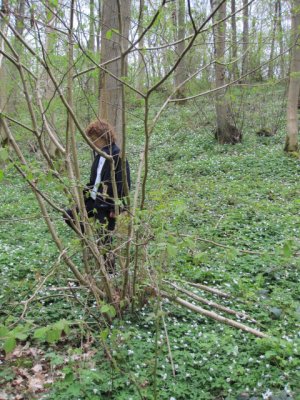 The first outdoor meeting of the season was attended by 12 members and we welcomed the fine sunny weather. Only one member braved shorts. We were fortunate enough to have the owner of Beadale Wood, Mrs Nicky Blyth, and her two children with us. We were pleased to hear that Nicky is focussed on best practice for maintaining the wide spread of flora and fauna in the wood, which has undergone conservation work. Some years ago part of it was worked for charcoal and although Nicky is keen for this to be re-established no one has come forward to take on the project. More recent work on keeping bramble at bay and coppicing hazel has been undertaken. Nicky showed us an example (seen here) of work carried out at the beginning of 2010 on coppicing and regenerating hazel to be planted elsewhere in the wood. Stems are laid down and pegged to allow re-rooting. Currently trees are being thinned at the lower end of the wood.
The first outdoor meeting of the season was attended by 12 members and we welcomed the fine sunny weather. Only one member braved shorts. We were fortunate enough to have the owner of Beadale Wood, Mrs Nicky Blyth, and her two children with us. We were pleased to hear that Nicky is focussed on best practice for maintaining the wide spread of flora and fauna in the wood, which has undergone conservation work. Some years ago part of it was worked for charcoal and although Nicky is keen for this to be re-established no one has come forward to take on the project. More recent work on keeping bramble at bay and coppicing hazel has been undertaken. Nicky showed us an example (seen here) of work carried out at the beginning of 2010 on coppicing and regenerating hazel to be planted elsewhere in the wood. Stems are laid down and pegged to allow re-rooting. Currently trees are being thinned at the lower end of the wood.
Beadale Wood lies just north of Wrelton in a narrow valley; evidence of limestone quarrying is present throughout. It is a long narrow wood with a public footpath running through the middle up the bottom of the steep-sided valley. Trees are predominantly ash and sycamore with some wych elm, oak, hawthorn, blackthorn and hazel. Ground flora is dominated in parts by ramsons, which as we often see, seems to stop suddenly, presumably where soil conditions become unfavourable. Wood anemone is extensive throughout, mainly white but patches ranging from pale to deep pink in places.
On leaving the village and traversing a small paddock Keith spotted a Holly Blue butterfly which was too quick for most of us to see. Before entering the wood from the south there is a small bank to the east with a few trees and flora suggesting it was once part of the wood or heavily dominated by trees. Here Nicky showed us a patch of Yellow Star of Bethlehem, which is locally not common. It had finished flowering and was probably at its best 2-3 weeks ago.
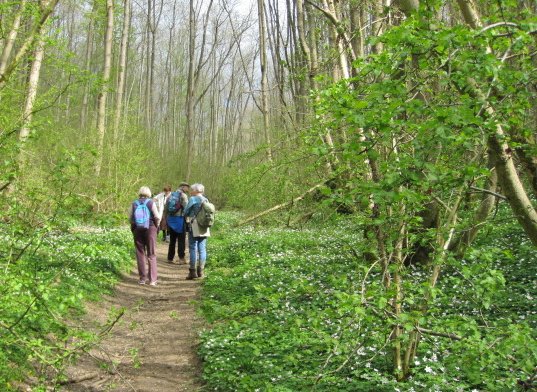
A full list of flora is at the end of this report but highlights were the small patches of Herb Paris (left below) with its leaves up and in bud. One flower was just about to burst. An extensive patch was on the left of the path. Another highlight was Lily of the Valley (right below), present in three patches near the top track on the east side, just coming into bud. This seems to be spreading nicely.
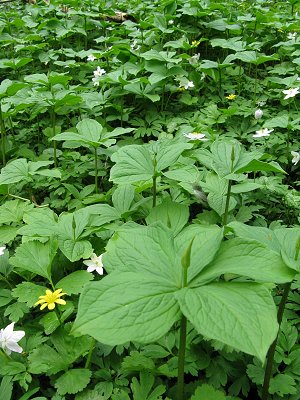
Herb Paris in bud |
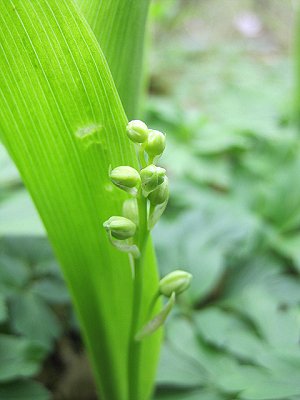
Lily of the valley |
Common Twayblade was seen in small but quite intensive patches on the same top track, again just in bud. Early Purple Orchids, two or three just in flower, are numerous along the east side. Near a quarry on the west side are more orchids (Early Purple and Butterfly); although we did not explore these today they will be monitored. Historically Globeflower has been present in the middle of the wood close to the path, on the east side, but it has not been seen in very recent years. We now have a clearer idea of where this is and will monitor the area.
Badgers are active in the wood and evidence of setts was seen on the east side. Male Orange-tip butterflies were frequent though we were unable to get a positive sighting on a female. We did get a Brimstone which passed us by and a mating pair of Green-veined whites. A full list of butterflies is at the end as are the bird and fungi records.
Andrew Grayson, our insect recorder, collected some specimens and a full list will be available when they have been identified. Of note was the presence of the red-tailed form of the nationally notable fly Criorhina ranunculi. All four forms of British Criorhina are fairly scarce and further visits to Beadale saw the other species, so all four are present here. Other interesting ‘deadwood’ hoverflies are locally common in Beadale Wood, including Ferdinandea cuprea, and at least one of the species of Brachyopa [specimens not yet determined]. The ‘deadwood’ fauna in Beadale wood is much better than average for woodlands in our area. Andrew made Nicky aware that the abundant deadwood and rotting bases of the trees were of importance to invertebrates. Andrew intends to monitor this woodland and it is hoped that a report will be produced for our next publication. (Many thanks to Andrew for these notes.)
The area of Beadale Wood owned by Nicky stops at the wide track running across the wood. The wood itself continues north and at some stage becomes Scorbern Plantation. Lunch was taken in this area and Nicky and family departed. We continued north through much the same woodland, rich in flora as before. Another extensive patch of Herb Paris was to the west of the junction with the bridleway. One Butterfly orchid was in bud just up the steep bridleway to the west.
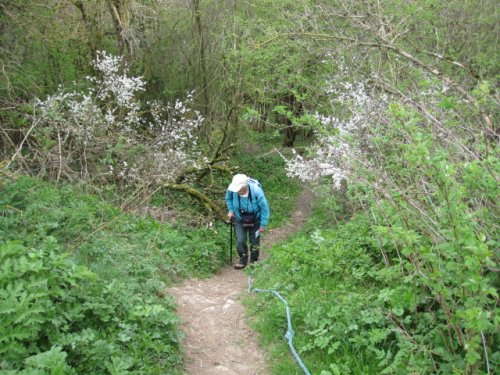 Some members took advantage of the blue knotted rope supplied to aid ascent of the steep path but not Nan.
Some members took advantage of the blue knotted rope supplied to aid ascent of the steep path but not Nan.
Here the bridleway took us out of the west side of the wood and through an arable field. We were richly rewarded with the sight of a pair (male and female) of yellow wagtails which were identified by Keith who picked them up through their call first of all. Thank you Keith.
At the end of the field we joined the quiet single track road leading south back to Wrelton. There is a rich verge with Dogwood in its hedgerow on the east side, and treats like Betony, Greater Knapweed and Creeping Cinquefoil yet to flower.
Ivy-leaved Speedwell was in flower (left below). What is not so clear from the photo is that it was the less frequent blue sub-species. What is clear from the photo is that this insignificant little ‘weed’ is actually rather beautiful in close-up.
We were also lucky to get a male Orange-tip settle on one of its principal food plants, Jack by the hedge, also known as hedge garlic from the smell of its crushed leaves. As seen here it obligingly closed its wings to show the marbled green camouflaged undersides (which the females also have).
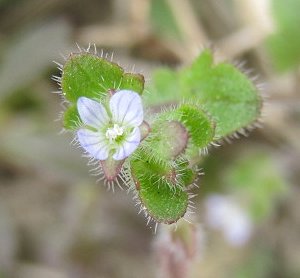
Ivy-leaved Speedwell |
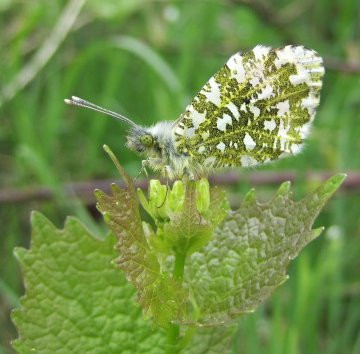
Orange-tip butterfly showing the wonderful markings on the underside – perfect camouflage when down amongst the leaves |
The first outing of the year, rich in wildlife. This wood is well worth a re-visit in May/June when more of the wild flowers will be at their best.
 The first outdoor meeting of the season was attended by 12 members and we welcomed the fine sunny weather. Only one member braved shorts. We were fortunate enough to have the owner of Beadale Wood, Mrs Nicky Blyth, and her two children with us. We were pleased to hear that Nicky is focussed on best practice for maintaining the wide spread of flora and fauna in the wood, which has undergone conservation work. Some years ago part of it was worked for charcoal and although Nicky is keen for this to be re-established no one has come forward to take on the project. More recent work on keeping bramble at bay and coppicing hazel has been undertaken. Nicky showed us an example (seen here) of work carried out at the beginning of 2010 on coppicing and regenerating hazel to be planted elsewhere in the wood. Stems are laid down and pegged to allow re-rooting. Currently trees are being thinned at the lower end of the wood.
The first outdoor meeting of the season was attended by 12 members and we welcomed the fine sunny weather. Only one member braved shorts. We were fortunate enough to have the owner of Beadale Wood, Mrs Nicky Blyth, and her two children with us. We were pleased to hear that Nicky is focussed on best practice for maintaining the wide spread of flora and fauna in the wood, which has undergone conservation work. Some years ago part of it was worked for charcoal and although Nicky is keen for this to be re-established no one has come forward to take on the project. More recent work on keeping bramble at bay and coppicing hazel has been undertaken. Nicky showed us an example (seen here) of work carried out at the beginning of 2010 on coppicing and regenerating hazel to be planted elsewhere in the wood. Stems are laid down and pegged to allow re-rooting. Currently trees are being thinned at the lower end of the wood. 


 Some members took advantage of the blue knotted rope supplied to aid ascent of the steep path but not Nan.
Some members took advantage of the blue knotted rope supplied to aid ascent of the steep path but not Nan.
